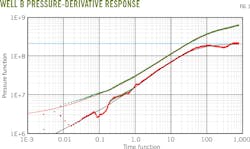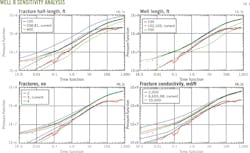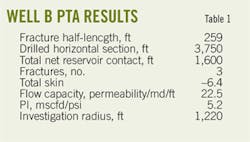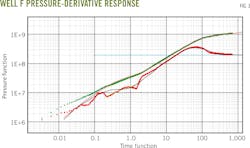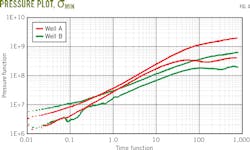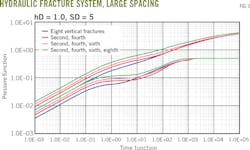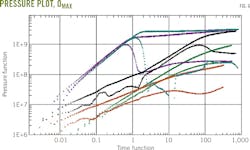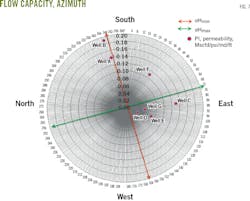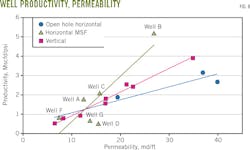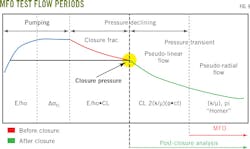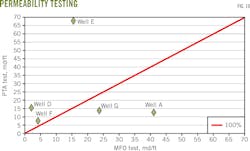Saudi carbonate MSF well analysis determines optimal horizontal drilling direction
Mahdi S. Al-Dawood
Ahmad A. Aziz
Zillur Rahim
Adnan A. Al-Kanaan
Ahmed M. Al-Omair
N.M. Anisur Rahman
Saudi Aramco
Dharan
Stress variations and drilling directions affect fracture geometry in open-hole multistage fracturing (MSF). Determining whether to drill toward the minimum horizontal stress (σmin) or maximum horizontal stress (σmax) impacts fracture behavior and ultimate production in tight, heterogeneous carbonate reservoirs.
This article presents modeling and interpretation of production and actual pressure-transient responses of horizontal, open-hole MSF wells in Saudi Arabia, drilled in both the σmin and σmax directions. It also evaluates fracture parameters such as half-length, conductivity, orientation, and number of fractures, and then looks at their impact on production and pressure behavior. Well testing and production analyses are used to assess and compare different types of flow regimes for horizontal open-hole MSF wells drilled in different azimuth directions.
The article discusses different derivative shapes captured during well tests and compares them to simulated models. The transmissibility values obtained from the mini falloff (MFO) test during fracture injectivity are compared with the flow capacity values calculated from the pressure transient analysis (PTA) and azimuthal recommendations are provided for similar formations.
Reservoir characteristics
The carbonate reservoir in this article is from the early Triassic, consisting mainly of dolomites, limestones, and anhydrites. It is heterogeneous with high variations of porosity, making development difficult.1 2
Average porosity and net pay in the productive reservoir layer varies from 6-10% and from 10-50 ft, respectively. The reservoir has an average permeability of 0.2 md and contains a high volume of gas in place.
Wells in this reservoir have been drilled in both the σmin and σmax directions with varying results. Initially, σmax drilling was used to mitigate stability risks. Later, the σmin was drilled to create transverse fractures during stimulation to improve recovery.
Drilling parallel to the σmin makes it difficult to control borehole breakouts. Applying real-time geomechanics where reservoir pressure and proper mud weight are computed based on logging-while-drilling data reduced this problem.
Before production, MFO tests assess completion performance. PTAs are used to understand reservoir and fracture behaviors and estimate their properties. PTA results are also used in calibrating inflow and outflow well performance, using wellbore-hydraulic models to design production strategy and predict well performance.
Transverse fractures
We reviewed seven horizontal wells (A, B, C, D, E, F, and G) with open hole MSF completions for which production and pressure data were collected and analyzed. Two of these wells were drilled toward σmin while the remaining five wells were drilled toward σmax. Well A and Well B drilling was in the σmin direction. This article focuses on Well B as a case-study proxy for both wells.
Initial Well B drilling created a vertical pilot hole across multiple reservoirs. It was sidetracked subsequently as a geometric single-lateral well across the carbonate reservoir in the σmin direction and completed with a five-stage, balanced, open-hole MSF system.
The lateral encountered about 1,300-ft net reservoir contact with 10% average porosity. Three stages were successfully fractured. Two stages had poor injectivity so the formation could not be broken down.
A deliverability test conducted after 2 months of production evaluated key reservoir and fracture parameters. Fig. 1 shows the pressure-derivative response from the PTA as having a reasonable analytical match to a fractured horizontal well in a homogeneous reservoir with an infinite boundary. A clear stimulation signature is visible through the linear flow.
Sensitivity analyses performed across four parameters (fracture half-length, well length, number of fractures, and fracture conductivity) assessed their impact on the derivative plot (Fig. 2).
The analyses show that increasing the number of fractures results in a lower pressure drop early in development. Similar results were found by increasing fracture half-length, with the pressure drop instead extending through the entire test.
Sensitivity analyses also show that increasing the horizontal well length will eventually result in delaying the radial flow regime, with less downward shift of the derivative plot. Table 1 shows the main PTA results for Well B.
Table 2 offers a summary of data for the stress direction and the number of fractured stages, as compared with planned stages, for Wells A-G.
Longitudinal fractures
Study of PTA for wells drilled in the σmax direction (Wells C-G) used Well-F as a proxy.
Well F was sidetracked as a geometric single lateral, 50° to σmin and completed with a four-stage, balanced, open-hole MSF across the carbonate reservoir. The sidetrack encountered 1,385-ft net reservoir contact with 5% average porosity.
Stage 1 development used acid fracturing, but the second, third and fourth stages were matrix acidized because communication occurred between the stages and fracturing pressure could not be established. A deliverability test conducted after 4 months of production evaluated key reservoir and fracture parameters.
Fig. 3 shows the response plot from Well F's pressure buildup test, reasonably matched by using a horizontal well in a homogeneous reservoir with an infinite boundary.
Wellbore storage effects masked the early-time region. The radial-flow regime was reached after about 300 hours, with key reservoir parameters calculated during this test period (Table 3).
The total net-reservoir contact is 60% of the total drilled length due to reservoir heterogeneity. The effective well length is almost half the total net-reservoir contact.
The total skin value of -4.43 shows effective stimulation, even though there is 1.35 skin damage due to flow restriction from the fracture to the wellbore.
Calculated flow capacity was very close to that obtained from injectivity testing and a linear flow was identified.
PTA observations
Fig. 4 shows a normalized log-log pressure plot for wells drilled in the σmin direction. Both wells show an early short-fracture radial flow, followed by a linear flow and, finally, a pseudo-radial flow.3 4
Well B confirms that more fractures result in longer linear flow. The late periods on both derivative plots show two radial flow regimes attributable to either reservoir heterogeneity or the boundary effect.
A transitional flow (close to linear) could also be separating the radial flows in each well.5 The larger the spacing between fractures, the longer this transitional period lasts.
Future well data can confirm these conclusions. The derivatives' shape, however, matches what has been modeled and simulated for a horizontal well intercepted by an infinite conductivity longitudinal fracture (Fig. 5).5 6
Fig. 6 compiles the normalized log-log responses for all wells drilled in the σmax direction and identifies distinct reservoir and fracture features. Well C, Well E, and Well F show an early clear linear flow. Well D and Well G do not exhibit hydraulic fracture behavior and are reasonably matched using only the horizontal well model.
The behavior of the other wells closely resembles horizontal wells with longitudinal fractures, consistent with their having been fractured in the σmax direction, but with a fracture signature masked by the wellbore storage. The shape of the derivatives matches what has been modeled and simulated for horizontal wells intercepted by an infinite conductivity longitudinal fracture.6
Well D and Well G are low producers compared to the rest of the wells (Fig. 7). The same figure shows that productivity is maximized when the well is drilled in the σmin direction.
Productivity, MFO tests
Comparing productivity of the open-hole MSF wells with the productivity of other completion methods used the productivity index (PI) and permeability data derived from the PTAs shows higher PI in open-hole MSF completions.
The comparison wells were a vertical cased-hole completion with single-acid fracturing and a horizontal open hole with acid matrixing (Fig. 8). Results showed that open hole MSF wells can provide a higher PI for this reservoir, with permeability at about 5-30 md/ft. Low stimulation effectiveness caused Well G and Well D to perform poorly compared to wells with other completions.
A downhole gauge recorded pressure as MFO injection tests conducted in the injection period when treated water is pumped into the formation creating a small fracture (Fig. 9). These measurements helped determine transmissibility values and reservoir pressures by identifying the pseudo-radial flow regime and other fracture parameters from linear flow after shut-in. The data are also used to calibrate main fracture design.
The reliability of this kind of test depends on good estimation of reservoir parameters, such as reservoir pressure and permeability.9
A pressure-transient response sometimes does not allow interpretation of the radial-flow region. The objective is to compare permeability values obtained from the MFO test with those from the PTA.
Table 4 shows calculated transmissibility values from the MFO test with permeability values for all wells. Many wells did not show reasonable values because pressure data showed communication between stages. The transmissibility values computed from the first stage therefore will likely be most accurate, because that stage occurs under virgin reservoir conditions.
Fig. 10 illustrates that only Well F and Well G reasonably matched in MFO tests, showing that permeability derived from the MFO test can be misleading, and that the PTA test provides the best permeability estimates.
Carbonate reservoir options
The results of this study should help operators in similar carbonate reservoirs.
Drilling in the σmin direction helps increases reservoir contact, creates more independent transverse fractures, and increases well performance. PTA results showing the normalized PI indicate that wells drilled in the σmin direction outperform wells drilled in the σmax direction.
Not all MSF wells exhibit the same flow regimes because the regime depends on the number of fractures, spacing between the fractures, fracture conductivity, and orientation of the fracture. Some wells drilled in the σmax direction did not show a clear fracture signature because the direction was not favorable for creating multiple independent fractures.
Sensitivity analyses show that a smaller pressure drop in the wellbore occurs as the number of fractures, well length, fracture half-length, and fracture conductivity increase.
Acknowledgments
The authors would like to thank Saudi Aramco for its assistance and permission to publish this paper.
References
1. Al-Dawood, M., Abdulaziz, A., Al-Omair, A., and Rahim, Z., "Performance Evaluation and Challenges Using Open Hole Multistage Fracturing Completion to Develop Tight Gas Reservoirs in Saudi Arabia," Saudi Arabia Section Technical Symposium and Exhibition, al-Khobar, Saudi Arabia, Apr. 21-24, 2014.
2. Al-Anazi, H.A., Abdulbaqi, D.M., Habbtar, A.H., and Al-Kanaan, A.A., "Successful Implementation of Horizontal Multistage Fracturing Enhanced Gas Production in Heterogeneous and Tight Gas Condensate Reservoir: Case Studies," Abu Dhabi International Petroleum Exhibition and Conference, Abu Dhabi, UAE, Nov. 11-14, 2012.
3. Hegre, T.M. and Larsen, L., "Productivity of Multifractured Horizontal Wells," European Petroleum Conference, London, Oct. 25-27, 1994.
4. Larsen, L. and Hegre, T.M., "Pressure Transient Analysis of Multifractured Horizontal Wells," SPE Technical Conference and Exhibition, New Orleans, Sept. 25-28, 1994.
5. Al Rebeawi, S.J. and Tiab, D., "Transient Pressure Analysis of a Horizontal Well with Multiple Inclined Hydraulic Fractures Using Type-Curve Matching," International Symposium and Exhibition on Formation Damage Control, Lafayette, La., Feb. 15-17, 2012.
6. Hegre, T.M., "Hydraulically Fractured Horizontal Well Simulation," European 3D Reservoir Modeling Conference, Stavanger, Apr. 16-17, 1996.
The authors
Mahdi S. Al-Dawood ([email protected]) is a reservoir engineer for Saudi Aramco's gas reservoir management department. He joined the company in June 2011 and has been working in well planning, pressure transient analysis, reservoir stimulation, reservoir surveillance, and well modeling. He holds a BS in petroleum and natural gas engineering from West Virginia University, Morgantown. He is a member of the Society of Petroleum Engineers (SPE) and is a Certified Petroleum Engineer.
Ahmad Azly Abdul Aziz ([email protected]) is lead engineer for the Uthmaniyah gas fields in Saudi Aramco's gas reservoir management department. He has 20-years'experience in oil and gas reservoir management. Aziz holds a BS in petroleum and natural gas engineering from Pennsylvania State University.
Zillur Rahim ([email protected]) is a senior petroleum engineering consultant with Saudi Aramco's gas reservoir management department, responsible for stimulation design, application and assessment of conventional and tight gas reservoirs. Rahim holds a BS from the Algerian Institute of Petroleum, Boumerdes, and an MS and PhD from Texas A&M University, all in petroleum engineering.
Adnan A. Al-Kanaan ([email protected]) is manager of Saudi Aramco's gas reservoir management department. He oversees nearly 1,000 carbonate and sandstone wells in more than 30 onshore and offshore fields with production reaching 10-bilion cu ft/d. Al-Kanaan holds a BS in chemical engineering from King Fahd University of Petroleum and Minerals (KFUPM), Dhahran.
Ahmed M. Al-Omair ([email protected]) is a reservoir engineer and supervisor for Saudi Aramco's gas reservoir management department. He oversees the Shedgum and Uthmaniyah fields. His expertise includes reservoir development, well testing and production forecasting. Al-Omair holds a BS from the University of Louisiana, Lafayette, and an MS from the University of New South Wales, Sydney, Australia, both in petroleum engineering.
N.M. Anisur Rahman ([email protected]) is a petroleum engineering consultant with Saudi Aramco's well testing department, where he designs and interprets transient tests on oil production and water injection wells. He holds a BS and MS in mechanical engineering from the Bangladesh University of Engineering and Technology, Dhaka, and a PhD in petroleum engineering from the University of Alberta, Edmonton.

